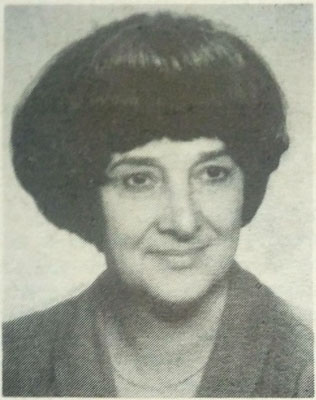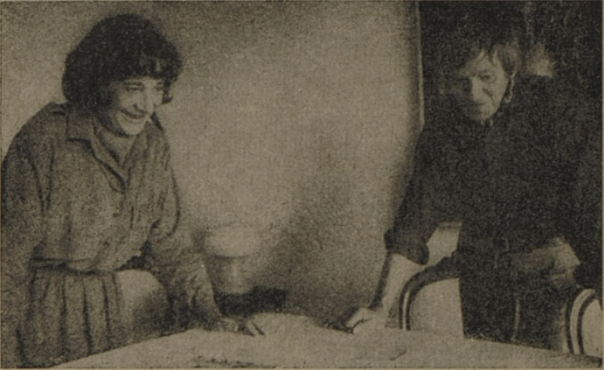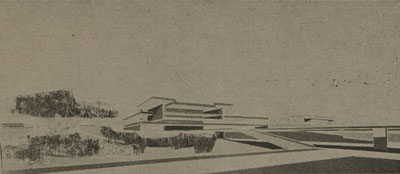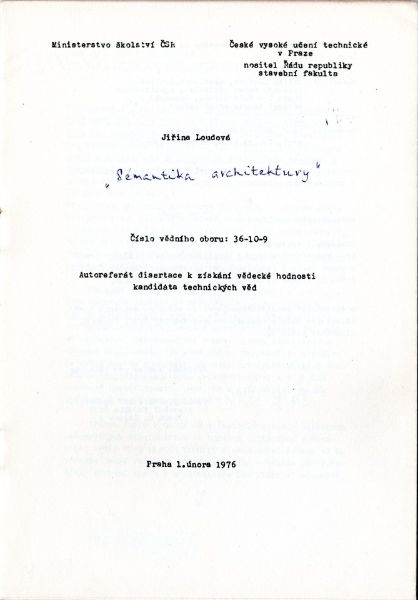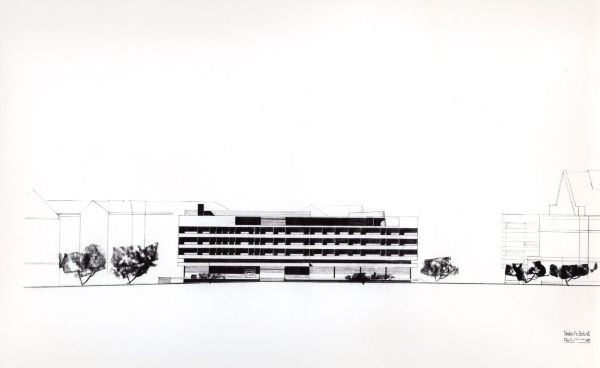Jiřina Loudová (née Polánková or Polanková, spellings vary) was born in 1928 in České Budějovice. It is unknown where she studied at the grammar school from which she graduated in 1944. Her mother married for the second time to Jaroslav Dvořáček, who worked as an architect/designer in Prague, and since Loudová later mentioned him as her stepfather, the marriage and the move to Prague may have taken place during her youth. Later Loudová studied at the Higher Industrial School of Construction in Prague and in 1948 finished her studies there with another graduation and a construction exam.
The first few years of Jiřina Loudová's professional career remain a question. She did not report any employment before the year 1955 when she joined the State Project Institute for the Construction of Towns and Villages (formerly Stavoprojekt). Jiřina Loudová worked here alongside her husband, architect Jiří Louda, among others. In her own words, she had the opportunity to spend her "apprenticeship years" in "a quality team working together on tasks that by their nature gave rise to thinking about the nature, meaning and purpose, and style of architectural creation" (Architektura ČSSR, XLVII 1988, p. 15). In 1958, the two were transferred to concern Konstruktiva allegedly as a result of political vetting, but further cooperation between Jiří Louda and Karel Filsak, Karel Bubeníček and Jan Šrámek for example on projects of embassy buildings in Beijing and Brazil, was not disrupted. Jiřina Loudová, on the other hand, was motivated by the stimulating environment to complete her architectural education. Due to her previous professional education and practical experience, she was in 1959 easily admitted to the Special School of Architecture at the Academy of Fine Arts run by Jaroslav Fragner at the time. In the second year of her studies, she won the main prize for her coursework in architecture and in 1962 she completed her studies with honours, excellent grades and enthusiastic reviews of her diploma project for the administrative building of the Lenin's factories in Prague. In the academic year 1962/1963 she was allowed a so-called honorary year of study at the Academy, for which she set as her programme the study of the Czechoslovak embassies in Geneva, London and Brasilia, referring to the fact that these were also her closest work assignments in Jan Šrámek's studio at Konstruktiva. The only known realization in which Jiřina Loudová took part – the interior of the Czechoslovakian embassy in Sofia, Bulgaria, on which she collaborated with Jan Šrámek and Zbyněk Hřivnáč, dates to this period. As part of the honorary year, Loudová also applied for support to travel to Japan to deepen her understanding of the development of Japanese architecture, on which she intended to further theoretically elaborate. It is not clear, whether she received the support to make the trip.
However, her interest gradually turned more towards theoretical work and to this end she continued her studies. From 1963 to 1965 she studied aesthetics at the Faculty of Arts of Charles University and in 1965 she took up an internal postgraduate position again with Fragner at the Academy of Fine Arts. She transferred to Oldřich Stefan as her tutor in 1967, yet soon after in the autumn of the same year Jiřina Loudová interrupted her studies and went on a study stay at the Technical University (Technische Hochschule) in Graz, Austria. During her studies, she worked in local architectural offices. She stayed abroad for two years instead of the one year planned and completed her studies with a dissertation regarding applying methodology derived from linguistics in architecture (Beitrag zu Einer Semantik der Architektur / Contribution to the Semantics of Architecture). This meant she also became the first woman–architect to receive a doctorate in technical sciences at TU Graz. She left her studies at the Academy of Fine Arts unfinished and after returning to Czechoslovakia she joined the Research Institute of Construction and Architecture, where she worked as a researcher for the next twenty years. In her publications, she first focused on the possibilities of applying semantics and semiotics in general to the study and evaluation of architecture. The period of her interest in architectural semantics culminated in her second doctoral dissertation defended at the Czech Technical University in Prague in 1976, in which she applied the semantic method practically to the analysis of the Church of St. Charles Borromeo in Vienna.
In the following five years, she returned to the Academy of Fine Arts, this time as an assistant professor at the School of Architecture. In addition to assigning and consulting on student work, she also taught the course Concepts of Contemporary Architecture regularly, and from 1980 she also supervised postgraduate students. In the 1980s, she began to focus her research work mainly on the problems of housing construction, its quality, planning possibilities, and subsequently on the question of regeneration of housing stock in historic buildings, in the expectation that it was in these areas that theory could be of benefit to architectural practice. After the 1989 revolution, Jiřina Loudová founded a private consulting firm, where she continued to use her erudition, for example, in cooperation with state programmes for the restoration of villages and the regeneration of urban conservation areas.
Architecture was Jiřina Loudová's main interest and she devoted herself with great dedication to her work in this field. She decided to devote herself primarily to theory, yet her extensive and elaborate work, perhaps because of its thematic focus and demanding language she used, or because of little interest in theory in general, has so far been outside the scope of professional attention.
Sources:
Archiv AVU [Archive of the Academy of Fine Arts in Prague], NAD 4, Jiřina Loudová – karta studenta, studentská složka, aspirantská složka Kt 167, zaměstnanecká složka Kt 170 [student card, student file, aspirant file Kt 167, employee file Kt 170]; Zápisy o státních závěrečných zkouškách šk. r. 1961/2 K 41/5.
-zč-, Otázky pro… Akad. arch. dr. Jiřinu Loudovou, CSc., a Ing. arch. Jiřího Loudu, Architektura ČSSR XLVII 1988, č. 4, s. 15–16.
Redakce nakladatelství Kdo je kdo [Editors of Who's Who Publishing House], Kdo je kdo 91/92: Česká republika, federální orgány ČSFR, Díl 1. A–M, Praha 1991, s. 550–551.
Jiřina Loudová, Politika bydlení v procesu regenerace chráněných území našich měst [Housing policy in the process of regeneration of protected areas of our cities], VÚVA, Praha 1994.
Olga Machatá – Marek Němec – Michael Třeštík, Kdo je kdo v České republice 94–95, Praha 1994, s. 331–332.
RS [Radomíra Sedláková], heslo: Louda, Jiří, in: Anděla Horová (ed.), Nová encyklopedie českého výtvarného umění, sv. 1, Praha 1995, s. 457.
RŠ [Rostislav Švácha], heslo: Šrámek, Jan, in: Anděla Horová (ed.), Nová encyklopedie českého výtvarného umění, sv. 2, Praha 1995, s. 839.
Michael Třeštík, Kdo je kdo v České republice na přelomu 20. století, Praha 1998, s. 352.
Michael Třeštík, Kdo je kdo. Architektura, Praha 2000, s. 92, 153.
Pozůstalost Jiřiny Loudové. [The Estate of Jiřina Loudová.]
Osobní rozhovor Barbory Řepkové se Zdenkou Aulickou [Personal interview of Barbora Řepková with Zdenka Aulicka (friend and colleague of Jiřina Loudová)], Praha, 25. 10. 2022.
Information from the TU Graz archive provided by Antje Senarclens de Grancy, 2024.
